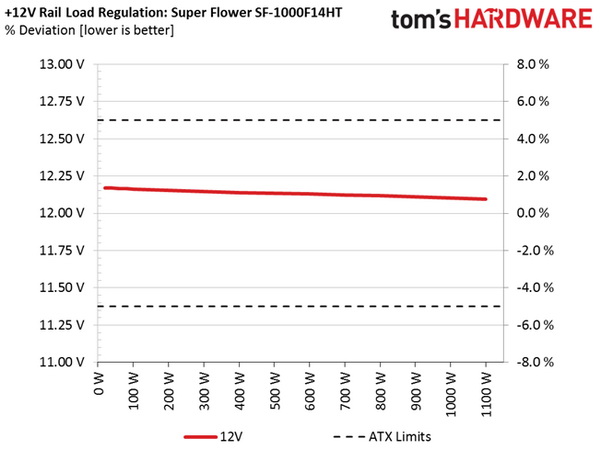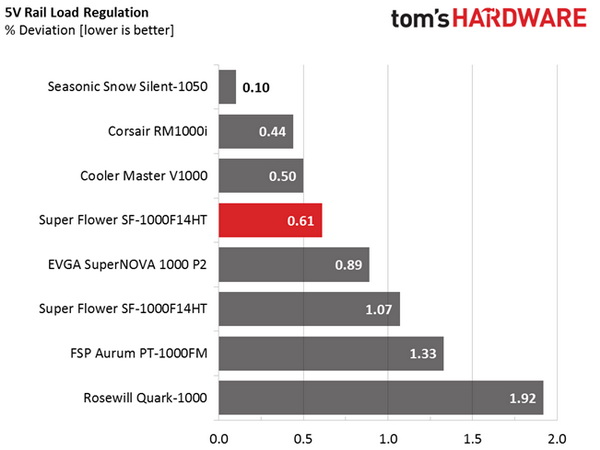Super Flower Leadex Titanium 1000W PSU Review
Super Flower was one of the first companies to release an 80 Plus Titanium-rated PSU. Following the ultra-high-capacity SF-1600F14H unit, the company released two more Titanium PSUs, one of which we're evaluating today.
Why you can trust Tom's Hardware
Load Regulation, Hold-Up Time And Inrush Current
To learn more about our PSU tests and methodology, please check out How We Test Power Supply Units.
Primary Rails And 5VSB Load Regulation
Load Regulation testing is detailed here.








Hold-Up Time
Our hold-up time tests are described in detail here.


Hold-up time on the SF-1000F-14HT PSU easily passes the 16ms threshold. That's possible thanks to the bulk caps' increased capacity.
Inrush Current
For details on our inrush current testing, please click here.


The large NTC thermistor does its job and doesn't allow the three bulk caps to generate increased inrush currents.
Load Regulation And Efficiency Measurements
The first set of tests reveals the stability of the voltage rails and the PSU's efficiency. The applied load equals (approximately) 10 to 110 percent of the maximum load the supply can handle, in increments of 10 percentage points.
Get Tom's Hardware's best news and in-depth reviews, straight to your inbox.
We conducted two additional tests. During the first, we stressed the two minor rails (5V and 3.3V) with a high load, while the load at +12V was only 0.10A. This test reveals whether a PSU is Haswell-ready or not. In the second test, we determined the maximum load the +12V rail could handle with minimal load on the minor rails.
| Test # | 12V | 5V | 3.3V | 5VSB | DC/AC (Watts) | Efficiency | Fan Speed (RPM) | Noise (dB[A]) | Temps (In/Out) | PF/AC Volts |
|---|---|---|---|---|---|---|---|---|---|---|
| 1 | 6.432A | 1.984A | 1.993A | 0.985A | 99.79 | 90.10% | 0 | 0 | 41.62 °C | 0.974 |
| 12.162V | 5.035V | 3.309V | 5.055V | 110.75 | 37.33 °C | 115.1V | ||||
| 2 | 13.889A | 2.979A | 2.993A | 1.185A | 199.66 | 92.66% | 0 | 0 | 43.40 °C | 0.989 |
| 12.154V | 5.029V | 3.305V | 5.048V | 215.47 | 38.86 °C | 115.1V | ||||
| 3 | 21.713A | 3.486A | 3.510A | 1.385A | 299.84 | 93.38% | 0 | 0 | 48.01 °C | 0.996 |
| 12.147V | 5.024V | 3.302V | 5.042V | 321.10 | 39.64 °C | 115.1V | ||||
| 4 | 29.524A | 3.983A | 3.999A | 1.585A | 399.59 | 93.32% | 0 | 0 | 50.75 °C | 0.995 |
| 12.140V | 5.020V | 3.299V | 5.035V | 428.21 | 40.47 °C | 115.1V | ||||
| 5 | 37.009A | 4.978A | 5.003A | 1.786A | 499.54 | 92.97% | 920 | 35.9 | 42.77 °C | 0.996 |
| 12.135V | 5.015V | 3.296V | 5.029V | 537.29 | 52.27 °C | 115.1V | ||||
| 6 | 44.497A | 5.986A | 6.010A | 1.990A | 599.57 | 92.32% | 920 | 35.9 | 43.06 °C | 0.997 |
| 12.131V | 5.009V | 3.294V | 5.022V | 649.47 | 53.31 °C | 115.1V | ||||
| 7 | 51.994A | 7.000A | 7.017A | 2.190A | 699.47 | 91.71% | 1365 | 46.2 | 44.83 °C | 0.997 |
| 12.124V | 5.003V | 3.291V | 5.015V | 762.67 | 55.28 °C | 115.1V | ||||
| 8 | 59.502A | 8.005A | 8.029A | 2.395A | 799.37 | 90.91% | 1830 | 52.2 | 45.41 °C | 0.998 |
| 12.117V | 4.996V | 3.288V | 5.008V | 879.35 | 56.31 °C | 115.1V | ||||
| 9 | 67.451A | 8.513A | 8.551A | 2.396A | 899.39 | 90.35% | 1830 | 52.2 | 46.56 °C | 0.998 |
| 12.110V | 4.990V | 3.285V | 5.005V | 995.50 | 57.84 °C | 115.1V | ||||
| 10 | 75.366A | 9.030A | 9.051A | 2.498A | 999.29 | 89.72% | 1830 | 52.2 | 47.09 °C | 0.998 |
| 12.102V | 4.986V | 3.281V | 5.000V | 1113.77 | 58.95 °C | 115.1V | ||||
| 11 | 83.663A | 9.032A | 9.056A | 2.500A | 1099.11 | 89.04% | 1830 | 52.2 | 48.38 °C | 0.998 |
| 12.095V | 4.984V | 3.279V | 4.998V | 1234.46 | 61.09 °C | 115.1V | ||||
| CL1 | 0.098A | 12.009A | 12.006A | 0.004A | 100.71 | 84.60% | 1365 | 46.2 | 45.42 °C | 0.978 |
| 12.165V | 4.994V | 3.292V | 5.067V | 119.05 | 52.83 °C | 115.3V | ||||
| CL2 | 83.261A | 1.003A | 1.003A | 1.002A | 1020.68 | 90.14% | 1830 | 52.2 | 46.73 °C | 0.998 |
| 12.098V | 5.019V | 3.295V | 5.038V | 1132.37 | 58.24 °C | 115.1V |
The first thing you should notice on a Titanium-rated PSU is its efficiency. The SF-1000F14HT performs extremely well, achieving very high efficiency levels in all of our load tests, despite high ambient temperatures inside of the hot box. The 80 Plus Titanium certification with 115VAC input demands at least 90, 92, 94 and 90 percent efficiency with 10, 20, 50 and 100 percent load, respectively. In this case, the PSU satisfies the 10 percent, 20 percent and full load requirements, but registers 1 percent less efficiency in the typical load test (50 percent). The results at lower operating temperatures should be better, and the PSU might even hit 94 percent efficiency with 50 percent load.
One thing is for sure: this is one of the most efficient PSUs that we have ever tested, and Super Flower makes sure to show that analog platforms can deliver extraordinary efficiency levels, given a good design and quality components. Aside from excellent efficiency, we also recorded very high PF readings, meaning that less power was wasted on the mains distribution network. Although typically consumers only pay for the reactive (not apparent) power we use, a PSU with a high PF ratio applies less stress to a home's mains network.
Overall, load regulation was tight enough on the +12V, 5V and 3.3V rails, staying within 1 percent. Moreover, the 5VSB rail falls below 1.5 percent. If Titanium efficiency wasn't a requirement, this PSU could easily achieve even tighter load regulation readings on all rails.
The PSU's fan started to spin during the 50 percent load test and continued to turn slowly at up to 60 percent load. However, the noise output was close to 36 dB(A), which is a noise level that may annoy users that are sensitive to noise. Under more taxing loads, the fan was noisy, and it hit full speed with 80 percent load and more. If you push this PSU hard, like we did, be prepared for noisy operation.
Current page: Load Regulation, Hold-Up Time And Inrush Current
Prev Page A Look Inside And Component Analysis Next Page Efficiency, Temperature And Noise
Aris Mpitziopoulos is a contributing editor at Tom's Hardware, covering PSUs.
-
AnimeMania Are modular cables interchangeable between the different power supply vendors or will this happen in the future.Reply -
blazorthon ReplyAre modular cables interchangeable between the different power supply vendors or will this happen in the future.
Some might be, but generally, don't expect interchangeable cables. There are many different implementations for the connectors for one reason or another. -
Aris_Mp ReplyAre modular cables interchangeable between the different power supply vendors or will this happen in the future.
It highly recommended to assume that they are not, even when the PSU is made by the same manufacturer.
-
Aris_Mp ReplySo, ah, what did you use as a price?
We used the price sold in EU stores, excluding the VAT of course. -
babernet_1 Reply17269051 said:So, ah, what did you use as a price?
We used the price sold in EU stores, excluding the VAT of course.
Which is? I looked and saw a price of 200 euro. That's about $220. Does it include VAT? -
babernet_1 Reply17273936 said:yes, in EU most stores include VAT in their prices.
My gosh! I just want to know in dollars what your estimated price was!
:??: -
Andi lim Using a bunch of KRG series capacitor for extra suppress ripple in Titanium PSU ?Reply
The Analogy : you want to build a super car, lets say Nissan GTR, but at the end you decide to use some cheap parts from Datsun on to your car, hahahaha.
The Question is, How long this PSU will stay in titanium level efficiency ?
Let's say after a year usage, the standard and cheap KRG capacitor will slowly increace the ESR, leak current dan temperature. at that time, this PSU efficient will go to platinum level or below ? Only time will tell.


